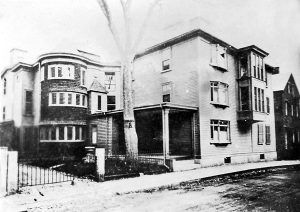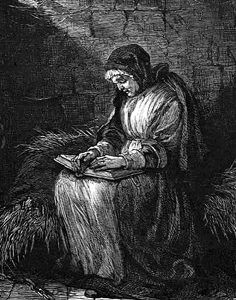Prisons:

The original Salem Jail, built in 1684, was replaced with this building on the same site in 1763. This jail remained in use until 1813 when it was remodeled into a home. It is gone today.
During the terrible witch hysteria of 1692, so many people were arrested; they were scattered in area village jails and Salem Towne, Boston, and Cambridge. However, most awaiting trials were held in the Salem Dungeon and Jail. Located near the North River, in Salem approved the dungeon’s construction in 1683, and the following year, the jail was completed. It was constructed of hand-hewn oak timbers and siding and measured 70 by 280 feet.
Boston’s jail was an open common room bordered by smaller rooms where some prisoners were locked at night. Like the smaller Essex County jails, it was set inside a fenced yard where less dangerous prisoners could exercise. Wealthy prisoners could even rent a room in the prison keeper’s house and attend religious meetings under guard. Many others were held in the Ipswich Jail, the second jail built in the Massachusetts Bay Colony in 1652.
All the jails, intended to hold prisoners temporarily, were hot in summer and cold in winter, infested with lice and stank of dung and tobacco. They were described by one visiting Englishman as “suburbs of Hell.” Though all of them were bad, the Salem Jail was said to have been the worst.
Conditions in jail were harsh for those accused of witchcraft. It was rat-infested and filthy, and the accused witches were often bound with cords and irons for months. The dungeon was cold and foul-smelling and kept in total darkness. Located near the north river, during high tide, it often flooded, with water rising to the prisoners’ ankles. They were also subjected to insulting, unending examinations and ex-communication from the church. The small cells had no bedding and no bars on the cells, as most prisoners accepted their punishment. For those who tried to escape, if they were caught, they would be immediately executed.
Many who were “examined” by authorities, who induced them to confess, were tortured, often by hog-tying their feet to their necks until blood dripped from their eyes and nose. Others were made to stand for long periods in a pillory, for hours, with arms outstretched. The examinations for witch marks were humiliating, as the accused were stripped of their clothing, and any blemishes pricked with pins and pinched, often in their most private parts. Water was often withheld from prisoners because the authorities believed they could get more “confessions” if they were thirsty.
A careful tally of every single item used by prisoners was kept during their imprisonment, and before anyone could be released, they were required to pay their tab. Prisoners were charged for straw bedding and food; if they could not afford them, they did without. They were also charged for their cells, and for prisoners who were poor and could not afford to pay, they were placed in coffin-like cells, smaller than a phone booth, in which they could only stand. They were also charged for their cuffs, chains, the fetters they were forced to wear, and the cost of examinations for witch marks. The basic fee was two shillings, sixpence a week – about as much as a woman could hope to earn in a week.
A sizable hangman’s fee would be paid if a prisoner was executed. Those hanged were taken from the jail by oxcart to Gallows Hill. Afterward, their dead bodies were left swaying as a lesson to others. They were thrown into a nearby ditch when the bodies were taken down. If a prisoner died under these horrible conditions, the family was required to pay for the removal of the corpse. It is estimated that more than a dozen people died in the prisons. One of which was Lydia Dustin, who had been arrested in April 1692. After spending almost nine months in prison, she was finally found not guilty by the Superior Court of Judicature in January 1693. However, she could not be released until she paid her jail fees. Unable to do so, she died in jail on March 10, 1693.
Despite its terrible conditions, the Old Salem Witch jail was a social gathering place. The staff would sell alcohol to those that came to visit. For a bond of £1, a prisoner could gain a day’s release to visit family; but had to return at night. A few more were able to bribe their way out of jail.
Dozens languished in these conditions for months without trials. At one point, there were as many as 150 people in the Salem dungeon. The youngest girl accused of witchcraft and imprisoned was four-year-old Dorcus Good. Both she and her mother, Sarah Good, were imprisoned in the Ipswich Jail. Sarah was accused of witchcraft in February 1692. She was tried, convicted, and sentenced to death. However, she was pregnant then, so her execution was delayed. While she was in jail, her four-year-old daughter, Dorcas, was arrested and jailed in March. Dorcas would witness the birth of her sister, Mercy Good, who died shortly after, probably due to malnutrition, lack of medical care, and unsanitary conditions. She would later witness her mother hanged on July 19, 1692. Dorcus would spend over eight months in jail before she was finally released. However, she would never be ok, and by some, judged insane.
Eventually, with the end of the witch hysteria, the Old Salem Witch dungeon was closed, and the land was sold. Later a Gothic-style house was built in 1813 on the site. The jail, which stood at 4 Federal St. and the corner of Saint Peter St., continued to be used until 1763, when it was replaced with another building. When another jail was built in 1813, the old one was remodeled into a home. Unfortunately, it was razed in 1957 to make way for the New England Telephone Company’s expansion.
Of those many accused people, 114 were arrested and held for many months in various jails. Forty-three were tried; 27 were convicted and sentenced to death; 19 were hanged, and one was pressed to death with stone weights. As many as a dozen people died in prison, including two nursing infants of jailed women. Two of the accused, later found innocent, were too poor to pay their jail fees and had to sell themselves into indentured servitude to obtain their release.

